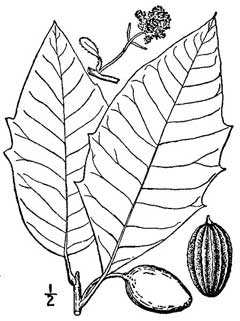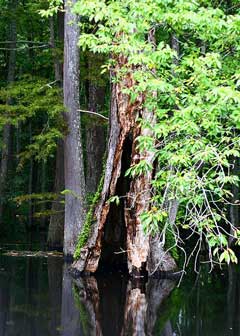 |
|
USDA / An illustrated flora of the northern United States, Canada and the British Possessions. Courtesy of Kentucky Native Plant Society |
 |
| www.flickr.com/photos/lucianvenutian |
Translate this page:
Summary
Bloom Color: White. Main Bloom Time: Early spring, Late spring, Mid spring. Form: Oval, Pyramidal.
Physical Characteristics

 Nyssa aquatica is a deciduous Tree growing to 30 m (98ft 5in) at a medium rate. It is in flower from April to May, and the seeds ripen in October. The species is hermaphrodite (has both male and female organs).
Nyssa aquatica is a deciduous Tree growing to 30 m (98ft 5in) at a medium rate. It is in flower from April to May, and the seeds ripen in October. The species is hermaphrodite (has both male and female organs).
Suitable for: light (sandy), medium (loamy) and heavy (clay) soils. Suitable pH: neutral and basic (mildly alkaline) soils. It can grow in semi-shade (light woodland) or no shade. It prefers moist or wet soil and can grow in water.
UK Hardiness Map
US Hardiness Map
Synonyms
N. uniflora.
Plant Habitats
Woodland Garden Canopy; Pond; Bog Garden;
Edible Uses
Edible Parts: Fruit
Edible Uses:
Fruit - occasionally eaten raw but more often used in preserves[177, 183]. The fruit is up to 4cm long, it has a thick, tough skin with a thin acid flesh surrounding a large seed[82, 229].
References More on Edible Uses
Medicinal Uses
Plants For A Future can not take any responsibility for any adverse effects from the use of plants. Always seek advice from a professional before using a plant medicinally.
None known
References More on Medicinal Uses
The Bookshop: Edible Plant Books
Our Latest books on Perennial Plants For Food Forests and Permaculture Gardens in paperback or digital formats.

Edible Tropical Plants
Food Forest Plants for Hotter Conditions: 250+ Plants For Tropical Food Forests & Permaculture Gardens.
More

Edible Temperate Plants
Plants for Your Food Forest: 500 Plants for Temperate Food Forests & Permaculture Gardens.
More

More Books
PFAF have eight books available in paperback and digital formats. Browse the shop for more information.
Shop Now
Other Uses
Cork Dye Wood
The wood of the roots is sometimes used for making floats instead of cork[82]. A red dye can be obtained from the burnt bark mixed with water and the ash of red oak (Quercus rubra)[257]. Wood - light, close-grained, soft, difficult to split[82, 229, 235]. Tough according to one report[235], weak according to another[229]. It has an intricately contorted and twisted grain[82]. It weighs 29lb per cubic foot[235], and is used for various things such as panelling, broom handles, woodenware and crates[82, 229]. It is sometimes exploited commercially[229].
Special Uses
References More on Other Uses
Cultivation details
Landscape Uses:Specimen, Woodland garden. Although this is a plant of swamps and other wet soils in the wild, once established it can succeed in Britain when growing in an ordinary good loamy soil in sun or semi-shade[1]. This plant probably requires a very wet soil, it is very difficult to establish in Britain, though it should be hardy at least in the milder parts of the country. It prefers a neutral to alkaline soil[200]. Plants are fast-growing in well-drained bottomlands in the wild, but slower in swampy sites[229]. They are long-lived trees, commencing to bear seeds when about 30 years old and usually producing heavy crops each year[229]. The seed is mainly distributed by water[229]. Resents root disturbance[1]. Plants in this genus are notably resistant to honey fungus[200]. Special Features:
North American native, Wetlands plant, Attracts butterflies, Inconspicuous flowers or blooms.
References Carbon Farming Information and Carbon Sequestration Information
Temperature Converter
Type a value in the Celsius field to convert the value to Fahrenheit:
Fahrenheit:
The PFAF Bookshop
Plants For A Future have a number of books available in paperback and digital form. Book titles include Edible Plants, Edible Perennials, Edible Trees,Edible Shrubs, Woodland Gardening, and Temperate Food Forest Plants. Our new book is Food Forest Plants For Hotter Conditions (Tropical and Sub-Tropical).
Shop Now
Plant Propagation
The seed can be sown in late winter in a cold frame[78] but would probably benefit from an earlier sowing if the seed can be obtained any sooner. Three months stratification at 5°c improves germination[200]. Germination rates are variable[78]. As soon as they are large enough to handle, prick the seedlings out into individual pots and grow them on in the greenhouse for at least their first winter. Plant them out into their permanent positions in late spring or early summer, after the last expected frosts. Cuttings of half-ripe wood, July/August in a frame. Layering.
Other Names
If available other names are mentioned here
Native Range
NORTHERN AMERICA: United States (Missouri (southeast), Illinois (south), Alabama, Arkansas, Florida, Georgia, Kentucky (southwest), Louisiana, Mississippi, North Carolina (east), South Carolina, Tennessee, Virginia (southeast), Texas).
Weed Potential
Right plant wrong place. We are currently updating this section.
Please note that a plant may be invasive in one area but may not in your area so it's worth checking.
Conservation Status
IUCN Red List of Threatened Plants Status :

Growth: S = slow M = medium F = fast. Soil: L = light (sandy) M = medium H = heavy (clay). pH: A = acid N = neutral B = basic (alkaline). Shade: F = full shade S = semi-shade N = no shade. Moisture: D = dry M = Moist We = wet Wa = water.
Now available:
Food Forest Plants for Mediterranean Conditions
350+ Perennial Plants For Mediterranean and Drier Food Forests and Permaculture Gardens.
[Paperback and eBook]
This is the third in Plants For A Future's series of plant guides for food forests tailored to
specific climate zones. Following volumes on temperate and tropical ecosystems, this book focuses
on species suited to Mediterranean conditions—regions with hot, dry summers and cool, wet winters,
often facing the added challenge of climate change.
Read More
Expert comment
Author
L.
Botanical References
1182229
Links / References
For a list of references used on this page please go here
Readers comment
| Add a comment |
|
If you have important information about this plant that may help other users please add a comment or link below. Only comments or links that are felt to be directly relevant to a plant will be included. If you think a comment/link or information contained on this page is inaccurate or misleading we would welcome your feedback at [email protected]. If you have questions about a plant please use the Forum on this website as we do not have the resources to answer questions ourselves.
* Please note: the comments by website users are not necessarily those held by PFAF and may give misleading or inaccurate information.
To leave a comment please Register or login here All comments need to be approved so will not appear immediately.
|
|